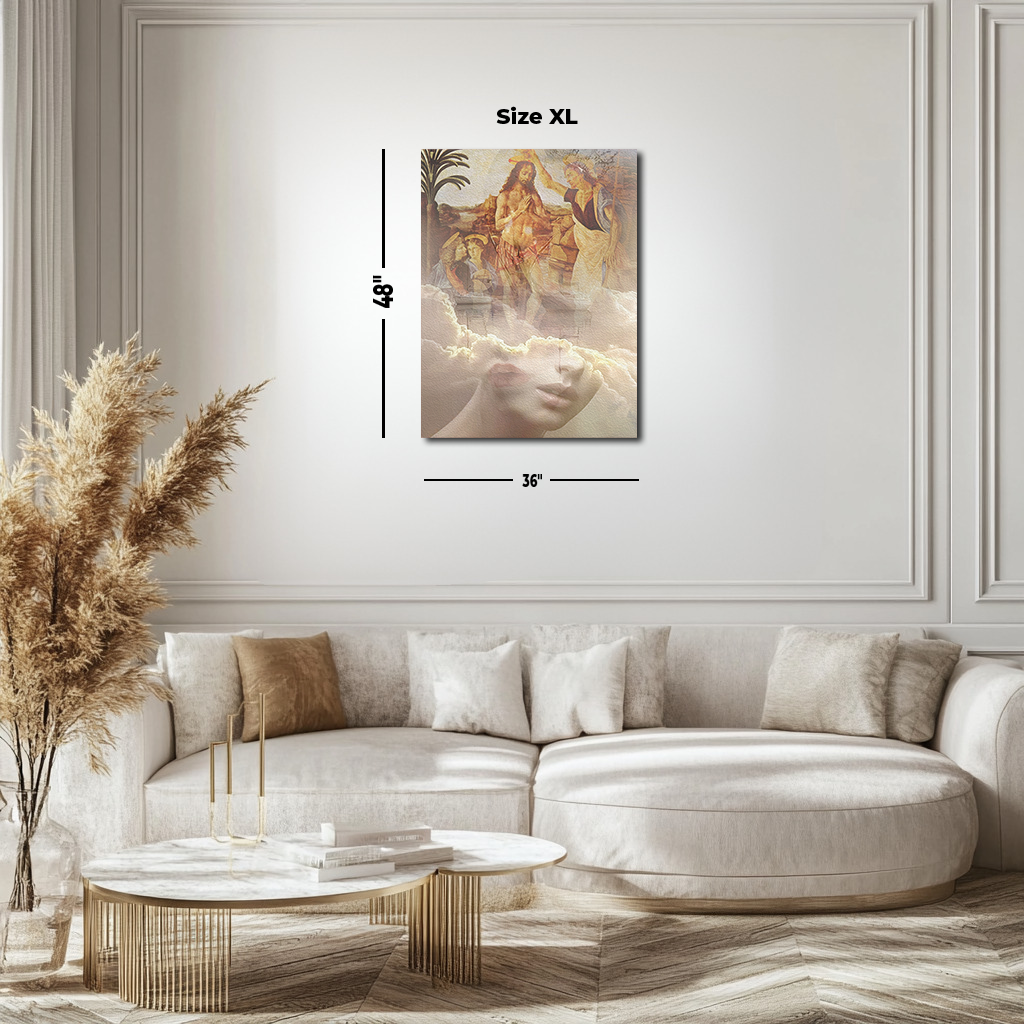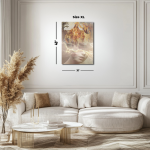Divine Confluence: Leonardo’s Vision of The Baptism of Christ Reimagined
"Divine Confluence: Leonardo’s Vision of The Baptism of Christ Reimagined" blends Renaissance artistry with modern surrealism, transforming a sacred moment into a timeless exploration of spirituality. Centered on Christ and John the Baptist, the composition incorporates ethereal elements like clouds and an abstract human visage, symbolizing the ongoing quest for divine connection. Warm earthy tones meet cool, ethereal hues, echoing Leonardo’s mastery of light and sfumato. This reinterpretation celebrates themes of transformation, renewal, and unity, bridging the gap between Renaissance ideals and contemporary introspection. The result is a multidimensional narrative that invites viewers to reflect on their spiritual journeys and the timeless relevance of Leonardo’s vision.
Please see Below for Details…
Hotline Order:
Mon - Fri: 07AM - 06PM
404-872-4663
Leonardo da Vinci’s collaborative masterpiece, The Baptism of Christ, created between 1474 and 1478, stands as a remarkable synthesis of divine symbolism, narrative brilliance, and groundbreaking technique. Produced with his mentor, Andrea del Verrocchio, this artwork was commissioned for the Church of San Salvi and currently resides in the Uffizi Gallery in Florence. This surreal narrative reinterpretation breathes new life into the iconic imagery by layering ethereal elements with modern sensibilities, transforming the sacred moment into a timeless meditation on spirituality and human transcendence.
At its core, the painting depicts the baptism of Jesus by John the Baptist, a moment of profound spiritual significance in Christianity. Leonardo’s contribution to this work is unmistakable, particularly in the angelic figure to the left of Christ and the handling of light, texture, and emotion throughout the composition. The angel, believed to be Leonardo’s creation, is rendered with an unprecedented delicacy and realism that marked a departure from the rigidity of earlier Renaissance figures. The soft curls of the angel’s hair, the graceful tilt of the head, and the subtle interplay of light and shadow demonstrate Leonardo’s early mastery of sfumato, a technique he would later refine in his solo works.
In this reimagining, the traditional scene is overlaid with surreal elements that expand its narrative and emotional depth. The central figures of Christ and John the Baptist retain their prominence, their gestures and expressions symbolizing humility, divine authority, and the sacredness of the moment. The translucent visage of a modern figure, half-submerged in clouds, emerges as a metaphor for humanity’s ongoing search for spiritual meaning. This ethereal face, blending seamlessly with the scene, connects the divine narrative to contemporary introspection, emphasizing the universality of the themes presented.
The inclusion of clouds as a framing device serves both a symbolic and aesthetic purpose. In Christian iconography, clouds often represent the divine presence and the mystery of God’s intervention in human affairs. Here, they envelop the composition, creating a dreamlike atmosphere that underscores the surreal quality of the reinterpretation. The soft hues of cream, white, and gold in the clouds evoke purity, peace, and the light of divinity, while their translucent texture suggests the permeability between the earthly and the celestial realms.
The color palette of the piece is an essential component of its narrative power. Leonardo and Verrocchio’s original utilized earthy tones of brown, ochre, and green to ground the scene in reality, while touches of gold and blue hinted at its spiritual dimensions. In this reinterpretation, these colors are heightened and expanded, with warmer tones dominating the figures and cooler tones infusing the background and clouds. The gentle gradation of light to dark within the clouds mirrors Leonardo’s sfumato technique, creating a seamless transition that guides the viewer’s eye across the composition.
One of the most striking features of this reinterpretation is the abstract interplay of lines and textures that overlay the scene. These geometric and organic patterns draw inspiration from Leonardo’s scientific studies, particularly his sketches of fluid dynamics and light. The faint appearance of ripples in the water beneath Christ and the swirling motion of the clouds echo Leonardo’s fascination with the interconnectedness of natural phenomena, a recurring theme in his work.
As an artist, this reinterpretation seeks to capture the essence of The Baptism of Christ while expanding its narrative scope. Leonardo’s original vision combined the divine with the human, portraying Christ as both a humble man and the Son of God. This reinterpretation amplifies this duality, juxtaposing the historical and the contemporary, the tangible and the transcendent. The addition of modern elements, such as the ethereal face and abstract overlays, bridges the gap between Renaissance ideals and present-day spiritual inquiries.
The emotional resonance of this piece lies in its exploration of transformation and renewal. Baptism, as a symbolic act, represents the washing away of sin and the beginning of a new spiritual journey. By incorporating modern motifs, this artwork invites viewers to reflect on their personal journeys of faith, redemption, and self-discovery. The subtle interplay of light and shadow, reminiscent of Leonardo’s mastery, reinforces the idea of emerging from darkness into light—a universal metaphor for enlightenment and spiritual awakening.
This reinterpretation also pays homage to Leonardo’s innovative approach to art, science, and philosophy. His ability to integrate meticulous observation with imaginative vision laid the groundwork for a new era of artistic expression. By reimagining The Baptism of Christ through a surreal and modern lens, this piece celebrates Leonardo’s enduring legacy and his belief in the unity of all knowledge.
Add your review
Your email address will not be published. Required fields are marked *
Please login to write review!
Looks like there are no reviews yet.










